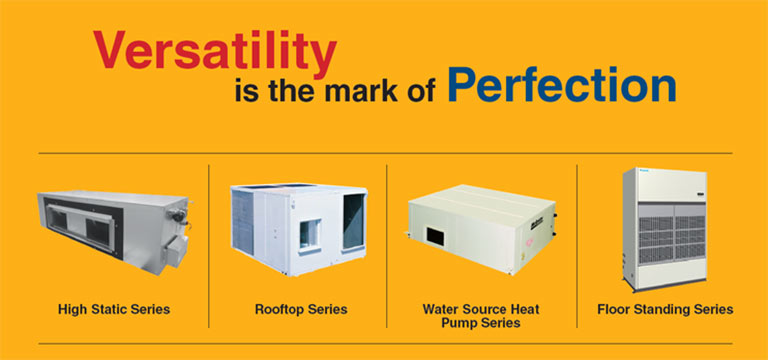
Today, 40 percent of the world’s population resides within the hot tropical regions where many of whom are exposed to potentially life-threatening temperatures for at least 20 days a year. Approximately 12,000 people die around the world annually due to heatwaves, and as our planet warms, these temperature surges are becoming more intense. Extreme heat often affects the most vulnerable populations, leaving them at risk. The World Health Organization estimates that, by 2050, more than 255,000 people could be killed annually from extreme heat waves.
Access to cooling can be an effective means of preventing fatalities caused by extreme heat stress – but unfortunately, people living in tropical and sub-tropical regions have dramatically lower access to cooling.
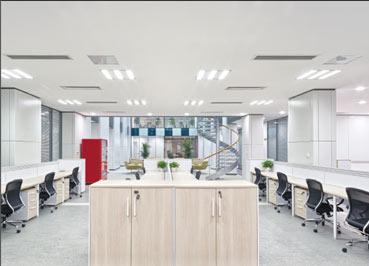
Of the 2.8 billion people living in the hottest parts of the world, only 8 percent currently have air conditioners, compared with 90 percent of people in the US and Japan. Access to cooling in many parts of the world can no longer be considered a luxury. Especially for the most vulnerable members of society, cooling access is a climate justice and equality issue. Cooling is not only important for enhancing the productivity, health and wellbeing of people but can, in some cases, be necessary for survival.
With growing urbanization, as the number of residential and commercial construction is on the rise globally, and there is rapid urban and economic growth in several countries, packaged airconditioners are making a place for themselves. Their demand is expected to grow considerably over the next five years. Estimated at USD 17,500 million and 24.5 million units in 2019, the analysts forecast the global packaged air conditioner market to grow at a CAGR of 5.29 percent during the period 2019-2021.
The North America market is expected to hold major share in the global HVAC packaged unit market. Europe is also projected to have high growth opportunities. There has been a significant rise in the number of manufacturers in the Western Europe HVAC packaged unit market, this would be a major growth opportunity for HAVC packaged unit market globally. APEJ region has been a lucrative market for HAVC packaged units, owing to rapid urbanization and rising income levels in countries, such as India, China and South Korea. In Latin America followed by MEA, HVAC packaged units are expected to have moderate growth over the next five years.
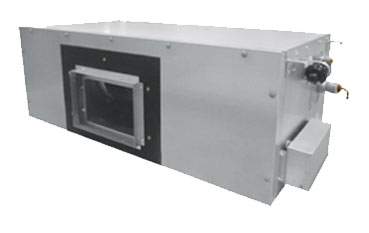
Air Cooled High Static Pressure Duct Type
Matured markets exhibit a high demand for elated demand for phonologically advanced and more energy-efficient HVAC packaged unit. This has made HVAC packaged unit a preferred choice, despite the fact that they are relatively high priced than the conventional one.
A positive change in the living standards along with an improving macroeconomic scenario has led to significant surge of various organized retail stores worldwide. The rapid growth of the organized commercial sector characterized by the rising number of hypermarkets, supermarkets, etc., is expected to boost the growth of the overall commercial chain, which in turn is expected to boost the overall sale of HVAC packaged unit. HVAC packaged units are ideal for conditioning in places such as restaurants, homes, telephone exchanges, and small halls. These ACs have high cooling and heating capacity and also capable of cooling the entire commercial building. They are increasingly adopted by various industry as business enterprise, healthcare industry and educational institutions due to their cost effectiveness and compact sizing. The all unit cooling coil, air filter, air handling unit and compressor are all lodged in a single casing and assembled at the factory location.
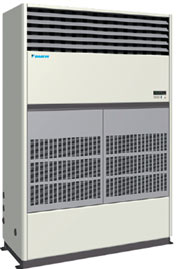
Air Cooled (Packaged) Floor Standing Type
Depending on the type of the cooling system used in these systems, the packaged air conditioners may be segmented as ones with water cooled condenser and the ones with air cooled condensers.
Air packaged air conditioners with water cooled condenser. In these, packaged air conditions the condenser, which is cooled by the water. The condenser is of shell and tube type, with refrigerant flowing along the tube side and the cooling water flowing along the shell side. The water has to be supplied continuously in these systems to maintain functioning of the air conditioning system.
The shell and tube type of condenser is compact in shape and it is enclosed in a single casing along with the compressor, expansion valve, and the air handling unit including the cooling coil or the evaporator. This whole packaged air conditioning unit externally looks like a box with the control panel located externally.
The compressor is located at the bottom along with the condenser. Above these components the evaporator or the cooling coil is located. The air handling unit comprising of the centrifugal blower and the air filter is located above the cooling coil. The centrifugal blower has the capacity to handle large volume of air required for cooling a number of rooms. From the top of the package air conditioners the duct comes out that extends to the various rooms that are to be cooled.
All the components of this package AC are assembled at the factory site. The gas charging is also done at the factory thus one does not have to perform the complicated operations of the laying the piping, evacuation, gas charging, and leak testing at the site. The unit can be transported very easily to the site and is installed easily on the plane surface. Since all the components are assembled at the factory, the high quality of the packaged unit is ensured.
Packaged air conditioners with air cooled condensers. In this packaged AC, the condenser of the refrigeration system is cooled by the atmospheric air. There is an outdoor unit that comprises of the important components like the compressor, condenser and in some cases the expansion valve. The outdoor unit can be kept on the terrace or any other open place where the free flow of the atmospheric air is available. The fan located inside this unit sucks the outside air and blows it over the condenser coil cooling it in the process. The condenser coil is made up of several turns of the copper tubing and it is finned externally.
The cooling unit comprising of the expansion valve, evaporator, the air handling blower and the filter are located on the floor or hanged to the ceiling. The ducts coming from the cooling unit are connected to the various rooms that are to be cooled.
The packaged ACs with the air cooled condensers are used more commonly than the ones with water cooled condensers since air is freely available and it is difficult maintain continuous flow of the water.
Most of the companies are focusing on technological advancements to meet with future customer requirements and to comply with global competence, which will further drive the demand in the HVAC packaged unit market.
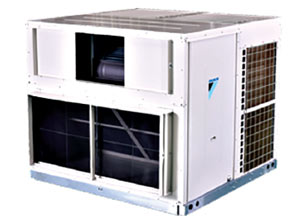
Air Cooled Rooftop
Smaller capacity, ceiling-mounted ACs with 4-way air outlets, thin profiles enabling installation in confined ceiling spaces, light weight, as less as 14 kg, enhancing construction ease, improved energy-saving performance, 5-horsepower models, reduced panel size, air inlets of honeycomb structure and flat outlet louvers resulting in functional proficiency are some of the enhanced features the manufacturers are incorporating in their models. Some top-of-the-line models have addon features which suppress unpleasant draftiness typically felt when air blows directly on a person, sensors that detect human presence and level of activity enabling optimal comfort and energy savings, significantly enhanced heat exchanging efficiency, higher energy performance through smaller diameter tube heat exchangers, and installation options which increase the choice of pipe extraction directions to six from the regular four.
In 1951, Daikin launched Japan's first packaged air conditioner to provide turnkey operation and began its lead as pioneer in the commercial use air conditioning market. Daikin offers an abundant range of packaged air conditioners for precise control of air and temperature to help preserve accurate results and product quality. These include:
Dual Fuel Systems. For cooling, this system uses an energy-efficient scroll compressor design with fewer moving parts that result in lower energy use compared to units with reciprocating compressors. A dual fuel packaged unit delivers yearlong comfort. This unit can automatically determine the most efficient fuel source to economically maintain your desired conditions within your home.
Gas/Electric Systems. A clear understanding of how people inhabit their living spaces has led to products designed to create indoor environments that use energy resources more effectively. For replacement or new construction, a Daikin packaged gas/electric unit offers the cooling comfort of an electric air conditioner and the heating benefits of a gas furnace.
Heat Pumps. Daikin brand packaged units sit on the ground or rooftop outside the home and deliver quiet, year-round comfort from a single, self-contained unit. These high-efficiency units operate as an air conditioner during warm weather, and in the winter deliver heat pump-generated warmth.
Some of the advantages of a Daikin airconditioner are:
- Energy and Cost Savings. Using advanced inverter and heat pump technologies increases efficiency and reduces energy consumption and costs.
- Wide Range of Solutions. Daikin provides a lineup to a wide range of applications that require high precision in temperature control and air quality.
- Control by Zone / Area. Daikin packaged air conditioners combine with ducts to distribute air only to zones and areas where needed.
Computer Server Rooms. Server rooms continue to expand and generate tremendous heat. To prevent loss of valuable data, Daikin offers specialized air cooling solutions to protect servers from heat.
Inverter Technology. Air conditioner compressors are driven by motor, and motor rotation speed depends on power supply frequency. An inverter modulates power supply frequency to control motor rotation speed. Inverters stabilize temperature by adjusting compressor operation according to load to eliminate waste and save energy. Even adopting an inverter to the fan motors of the indoor and outdoor units provides more precise control and contributes to energy savings.
As living standards rise for tens of millions of Indian people, the enormous expansion in room and vehicle air conditioning could strain the country’s electric grid, require increased fuel import, and magnify the impacts of global warming as a consequence of carbon dioxide and refrigerant greenhouse gas emissions. Choices made in the next few years will shape whether Indian consumers, companies and government authorities can turn the challenges of the air conditioning expansion into business advantage and national opportunity while reducing climate change, improving air quality, and making air conditioning more efficient and less costly to operate.

